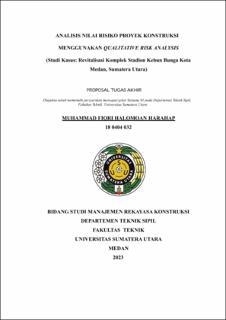Analisis Nilai Risiko Proyek Konstruksi menggunakan Qualitative Risk Analysis (Studi Kasus : Proyek Revitalisasi Komplek Stadion Kebun Bunga Medan, Sumatera Utara)

Date
2023Author
Harahap, Muhammad Fiqri Halomoan
Advisor(s)
Syahrizal
Metadata
Show full item recordAbstract
Construction projects are a form of activity that takes place within a limited
period of time. Likewise with construction projects in the city of Medan. The
implementation of a construction project anywhere and in any form will never
avoid risk, be it small-scale or large-scale risks. Based on this background, it is
necessary to conduct research to determine the level of risk in a project. This
research aims to analyze the risk value of construction projects in the Kebun Bunga
Stadium Complex Revitalization Project in Medan City, North Sumatra. This
research uses the qualitative risk analysis method which has two objectives, namely
risk identification and initial risk assessment. Furthermore, the steps taken are
identification and classification of risks, and analysis of risk values and also use the
help of statistical software, namely SPSS V.22 to conduct validity and reliability
tests. Valid and reliable requirements are if the validity value of r count> r table
and Cronbach's alpha value> r table. After that, the risk will be categorized based
on the severity index value, and to determine the level of risk, a risk profile map is
used as well as an assessment of the risk using qualitative risk analysis. Based on
data processing, there are 32 (thirty-two) risk factors that qualify after validity and
reliability tests. Likewise with the risk level, there are 42 (forty-two) eligible risk
factors. From the results of the risk profile map, a low risk level of 25 (59.52%)
was obtained and 17 risk factors (40.47%) were tolerable. There are two most
dominant risk factors, namely the manager's inability to manage in the field and the
inappropriate formwork removal time. The dominant risk factor is risk retention.
So as to minimize the possibility of loss and reduce the severity if a risk occurs
Collections
- Undergraduate Theses [1607]
